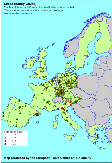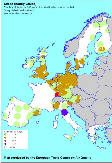3
SUMMARY OF DATA REPORTED FOR SUMMER 1996
The threshold for warning of the public
(1h> 360 µg/m3) was exceeded at three stations during summer
1996 (Table 3):
Table 3: Observed exceedances of the
threshold for warning of the public (1h concentration > 360
µg/m3) during summer 1996 (April-July).
| Country |
City |
Station |
Maximum observed hourly
concentration (µg/m3) |
Date |
Time |
| |
Greece |
Athens |
Marousi |
361 |
21-5-96 |
12.00 |
|
| |
Greece |
Athens |
Liosia |
391 |
21-5-96 |
13.00 |
|
| |
Italy |
Firenze |
Settignano |
387 |
13-7-96 |
9.00 |
|
|
Both the Athens and Firenze (Florence)
episode will be described in more detail in Chapter 4. Table 4
presents a general overview of the observed exceedances of the
threshold for information of the public during April-July 1996 on
a country by country basis. As the number of stations differs
widely from country to country, the absolute number of
exceedances are less suitable for comparison. As in the annual
ozone report [4], the concept of 'occurrence of exceedances' is
used here. Occurrence of exceedances is defined as the total
number of exceedances summed over all stations divided by the
number of stations.
Table 4: Summary of exceedances of the
threshold for information of the public (1h concentration >
180 µg/m3) during summer 1996 (April-July) on a country by
country basis.
| Country |
Nr. of
stations |
Nr. of
stations with exceed- ance |
Nr. of
days with exceed- ance |
Maximum
observed concentr. (µg/m3) |
Averaged
maximum concentr. (µg/m3) |
Occurr-
ence of exceed- ances |
Average
duration of exceed- ances (hour) |
|
| |
AT
|
114 |
52 (46%) |
18 |
225 |
191 |
0.9/1.9 |
3.4 |
|
| |
BE
|
22 |
12 (55%) |
6 |
244 |
200 |
1.2/2.3 |
3.9 |
|
| |
DE
|
386 |
229 (59%) |
29 |
271 |
196 |
1.6/2.7 |
3.0 |
|
| |
DK
|
6 |
1 (17%) |
1 |
198 |
198 |
0.2/1.0 |
3.0 |
|
| |
ES
|
132 |
31 (24%) |
27 |
323 |
202 |
0.8/3.2 |
2.3 |
|
| |
FI
|
11 |
1 (1%) |
2 |
190 |
186 |
0.2/2.0 |
1.0 |
|
| |
FR
|
155 |
56 (36%) |
41 |
273 |
199 |
1.4/3.9 |
2.5 |
|
| |
GB
|
42 |
23 (55%) |
11 |
244 |
194 |
0.9/1.7 |
2.8 |
|
| |
GR
|
11 |
9 (82%) |
40 |
391 |
235 |
9.3/11.3 |
2.9 |
|
| |
IE
|
6 |
0 (0%) |
0 |
- |
- |
- |
- |
|
| |
IT
|
69 |
36 (57%) |
39 |
387 |
206 |
2.8/5.3 |
2.9 |
|
| |
LU
|
5 |
2 (40%) |
4 |
199 |
190 |
1.2/3.0 |
2.0 |
|
| |
NL
|
38 |
31 (82%) |
8 |
265 |
200 |
2.4/3.0 |
3.3 |
|
| |
PT
|
9 |
3 (33%) |
5 |
251 |
202 |
0.6/1.7 |
1.4 |
|
| |
EU |
1012 |
489 (48%) |
|
391 |
200 |
1.5/3.1 |
2.9 |
|
|
In northern and western Europe, the weather
conditions during the 1996 summer season were on average less
favourable for the formation of ozone then during the 1995 summer
season. This year, cool and relatively clean Atlantic air masses
prevailed on many days. In 1995 a number of heat-waves were
recorded and especially July was very hot and sunny. As a result,
less exceedances were reported this summer (April-July)
than in the same period last year. In the Mediterranean region of
southern Europe, frequent exceedances were observed during the
stable, warm and sunny summer months.
Ireland was the only Member State where the
threshold for the information of the public was not exceeded. In
other countries, the number of days on which at least one
exceedance was observed ranged from one in Denmark to 41 in
France. 48% of all stations reported one or more exceedance.
During the same period in 1995, 59% of all stations reported one
or more exceedance. On average 3.1 exceedances occurred this year
on stations which recorded at least one exceedance. During summer
1995 on average 5.0 exceedances were recorded. The average
maximum hourly concentration during an exceedance of the
threshold this year was 200 µg/m3 which is slightly lower than
last year (EU average 1995: 203 µg/m3). An exception is Greece,
where the average maximum rose from 219 to 235 µg/m3. The
average length of an exceedance period was 2.9 hours (3.5 hours
in 1995). However, from Table 4 it is clear that there is quite a
large difference in the average episode length between the Member
States.
Table 5 summarises the exceedances on a
month by month basis. June had the highest number of stations
reporting exceedances and the highest occurrence. This is mainly
due to one ozone episode in the beginning of June in NW-Europe
(see also Chapter 5).
Table 5: Summary of exceedances of the
threshold for information of the public (1h concentration >
180 µg/m3) during summer 1996 (April-July) on a month by month
basis.
| |
Nr. of
stations with exceedance |
Maximum
observed concentration (µg/m3) |
Averaged
maximum concentration (µg/m3) |
Occurrence
of exceedances |
Average
duration of exceedances (hr) |
|
| April |
135
(13%) |
254 |
190 |
0.2/1.8 |
3.0 |
| May |
134
(13%) |
391 |
208 |
0.2/1.4 |
3.0 |
| June |
388
(38%) |
387 |
201 |
0.8/2.1 |
3.0 |
| July |
112
(11%) |
323 |
202 |
0.2/2.1 |
2.6 |
|
In Figure 1 the number of days per month is
presented on which at least at one station in a country was
recorded an exceedance. Again, the relative abundance of
exceedances in June is striking. Figure 2 presents the occurrence
of exceedances per country on a month by month basis. No monthly
pattern is apparent. Exceedances in June were observed on many
stations, the occurrence in this month is not significantly
different from that in other months. Exceedances in Greece and
Italy were observed on a limited number of stations; this
explains the relative high occurrence of exceedances in these
countries.
Figure 1: Number of days on which at least one
exceedance of the threshold value for information of the public
(1h concentration > 180 µg/m3) was observed per country and
per month during summer 1996.
Figure 2: Occurrence of exceedances (in days) of
the threshold value for information of the public (1h
concentration > 180 µg/m3) per country on a month by month
basis during summer 1996.
The average occurrence of exceedances (in
days) in each country of the threshold for information of the
public by station type (rural, urban and street) is presented in
Figure 3. The occurrence of exceedances generally decreases in
the order rural-urban-street. Stations for which the type was not
specified are not presented in this figure.
Figure 3: Average occurrence of exceedances (in
days) of the threshold for information of the public (1h
concentration > 180 µg/m3) by station type (rural, urban and
street) and country.
Figure 4 shows the frequency distribution
of hourly ozone concentrations in excess of the threshold value
using Box-Jenkins plots. For each Member State the Box-Jenkins
plot indicates the minimum (here the minimum is 180 µg/m3), the
maximum, the 25 percentile and the 75 percentile value of the
exceedances. The figure shows that during 25% of all observed
exceedances, the maximum hourly concentration recorded was just
above the 180 µg/m3 threshold. 75% of all maximum exceedances
recorded were below 208 µg/m3. During the same period last year,
the 75 percentile was ca. 6% higher.
| |
AT |
BE |
DE |
DK |
ES |
FI |
FR |
GB |
GR |
IE |
IT |
LU |
NL |
PT |
SE |
|
| #Ex |
99 |
27 |
607 |
1 |
99 |
2 |
217 |
38 |
102 |
0 |
191 |
6 |
92 |
5 |
7 |
| #St |
114 |
22 |
386 |
6 |
132 |
11 |
155 |
42 |
11 |
6 |
69 |
5 |
38 |
9 |
6 |
|
Figure 4: Frequency distribution of ozone
concentrations in excess of the 180 µg/m3 threshold
for hourly values (April-July 1996). For each country the total
number of observed exceedances is given in row '#Ex', the number
of stations is given in row '#St'. Frequency distributions are
presented as Box-Jenkins plots indicating the minimum, the
25-Percentile, the 75-percentile and the maximum value.
Geographical
distribution
Maps 2 and 3 show the geographical
distribution of the number of days on which the threshold value
for information of the public was exceeded for urban and
background stations, respectively. Exceedance data for urban
stations are presented as dots. The exceedance data for rural
stations are interpolated using simple inverse distance weighting
and a tentatively estimated 'radius of representativeness' of 100
km. Note that this radius might be different for the various
regions in Europe. Calculation should be based on more detailed
analysis of the ozone phenomenology at the stations in future.
No simple spatial structure is visible as
far as exceedances at urban stations are concerned. Note that
information for July from Spain is missing, that the reporting
period is only 4 months and stations of unspecified type are also
plotted in this map. The interpolated exceedance map for rural
locations is too fragmented to draw firm conclusions on spatial
patterns. The rural stations cover approximately 47% of the EU
territory. The area where exceedances were observed, calculated
on basis of the interpolated map, is approximately 48% of the
total area covered by background stations which is estimated at
23% of the total EU territory.
 |
Map
2: Number of
exceedances of the threshold value for the information of
the public (1h > 180 µg/m3) observed at urban
stations and stations of unspecified type. Summer 1996
(April-July). |
 |
Map
3: Number of
exceedances of the threshold value for the information of
the public (1h > 180 µg/m3) observed at background
stations. Summer 1996 data (April-July), interpolated
using inverse distance weighting and a cut-off distance
of 100 km. |



Document Actions
Share with others